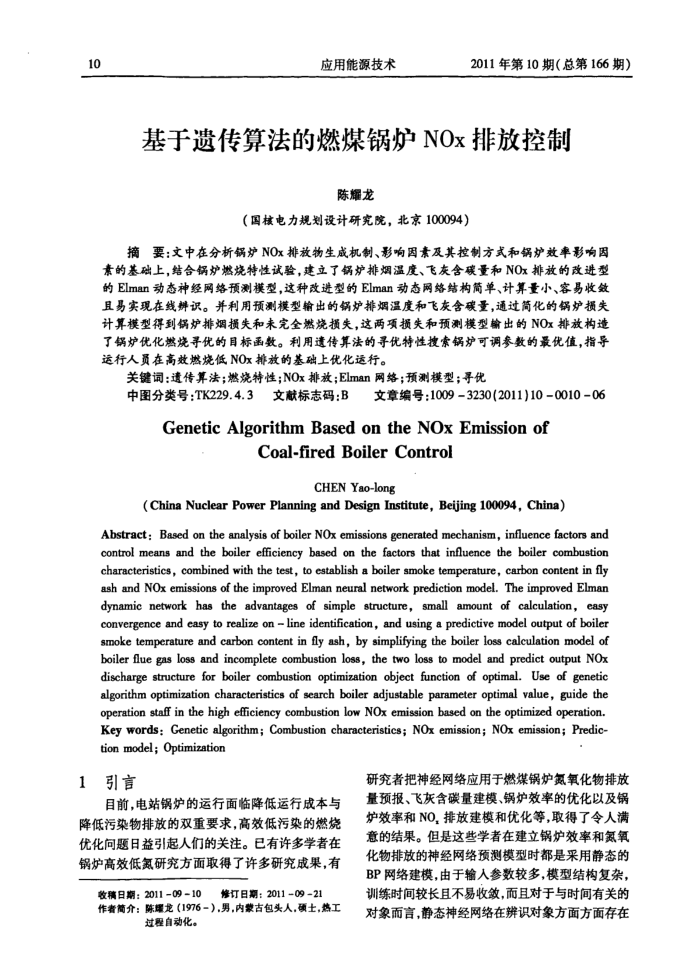您当前的位置:首页>论文资料>基于遗传算法的燃煤锅炉NOx排放控制
内容简介
 10
10应用能源技术
2011年第10期(总第166期)
基于遗传算法的燃煤锅炉NOx排放控制
陈耀龙
(国核电力规划设计研究院,北京100094)
摘要:文中在分析锅炉NOx排放物生成机制、影响因素及其控制方式和锅炉效率影响因素的基础上,结合锅炉燃烧特性试验,建立了锅炉排烟温度、飞灰含碳量和NOx排放的改进型的Elman动态神经网络预测模型,这种改进型的Elman动态网络结构筒单、计算量小、容易收效且易实现在线辨识。并利用预测模型输出的锅炉排烟温度和飞灰含碳量,通过简化的锅炉损失计算模型得到锅炉排烟损失和未完全燃烧损失,这两项损失和预测模型输出的NOx排放构造了锅炉优化燃烧寻优的目标函数。利用遗传算法的寻优特性搜索锅炉可调参数的最优值,指导
运行人员在高效燃烧低NOx排放的基础上优化运行。
关键词:遗传算法;燃烧特性;NOx排放;Elman网络;预测模型;寻优
中图分类号:TK229.4.3
3文献标志码:B
文章编号:1009-3230(2011)10=0010-06
GeneticAlgorithmBasedontheNOxEmissionof
Coal-firedBoilerControl
CHENYao-long
(China Nuclear PowerPlanning andDesignInstitute,Beijing100094,China)
Abstract: Based on the analysis of boiler NOx emissions generated mechanism, influence factors and control means and the boiler efficiency based on the factors that influence the boiler combustion characteristics, combined with the test, to establish a boiler smoke temperature, carbon content in fly ash and NOx emissions of the improved Elman neural network prediction model. The improved Elman dynamic network has the advantages of simple structure,small amount of calculation,easy convergence and easy to realize on line identification, and using a predictive model output of boiler smoke temperature and carbon content in fly ash, by simplifying the boiler loss calculation model of boiler flue gas loss and incomplete combustion loss, the two loss to model and predict output NOx discharge structure for boiler combustion optimization object function of optimal. Use of genetic algorithm optimization characteristics of search boiler adjustable parameter optimal value, guide the operation staff in the high efficiency combustion low NOx emission based on the optimized operation Key words: Genetic algorithm; Combustion characteristics; NOx emission; NOx emission; Predic-tion model; Optimization
1引言
目前,电站锅炉的运行面临降低运行成本与降低污染物排放的双重要求,高效低污染的燃烧优化问题日益引起人们的关注。已有许多学者在锅炉高效低氮研究方面取得了许多研究成果,有
收稿日期:201109=10
修订日期:2011-09-21
作者简介:陈埋龙(1976-),男,内蒙古包头人,硕士,热工
过程自动化。
研究者把神经网络应用于燃煤锅炉氮氧化物排放量预报、飞灰含碳量建模、锅炉效率的优化以及锅炉效率和NO,排放建模和优化等,取得了令人满意的结果。但是这些学者在建立锅炉效率和氮氧化物排放的神经网络预测模型时都是采用静态的 BP网络建模,由于输入参数较多,模型结构复杂,训练时间较长且不易收敛,而且对于与时间有关的对象而言,静态神经网络在辨识对象方面方面存在
上一章:煤粉锅炉微油点火低氮燃烧技术的理论研究
下一章:正反烧锅炉的燃烧操作技术